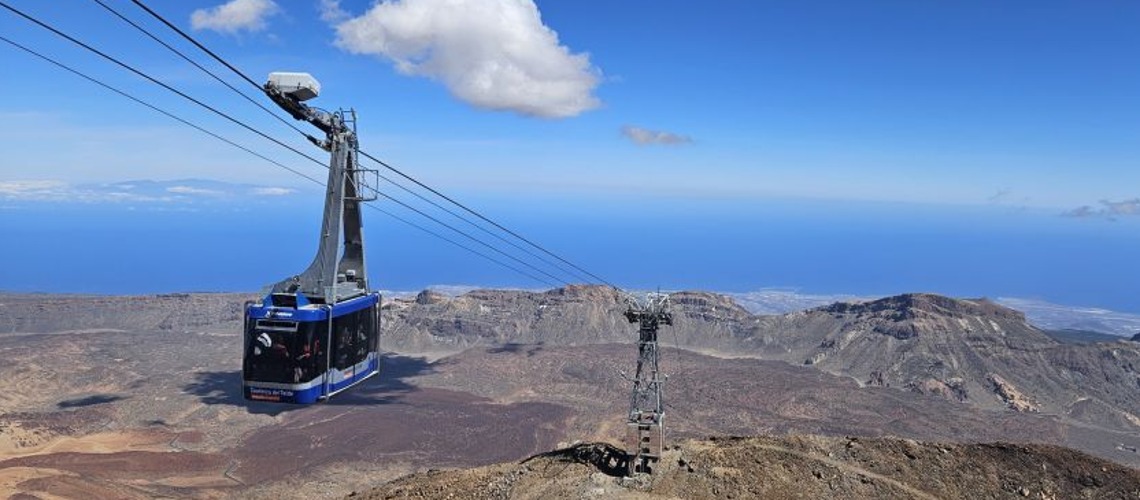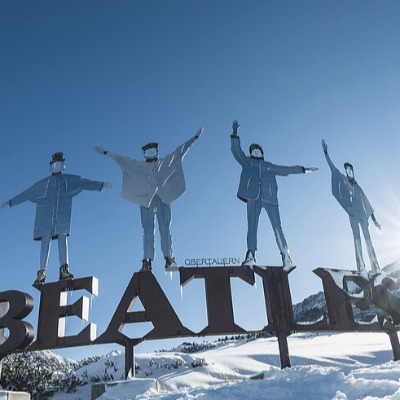Garaventa - Solar Energy For Tenerife’s Teide Cable Car. Sustainable Innovation

The cable car to Spain's highest mountain, the Pico del Teide (3,715 m) on Tenerife, has been using solar energy since summer 2024. For over 50 years, the cable car was powered by diesel engines, but now 525 photovoltaic modules provide most of the energy needed - an important step for nature conservation in the UNESCO World Heritage Site.
Thanks to the intelligent energy system ESFOR (Energy Storage System For Ropeways), developed and installed by Frey Stans, the cable car's fluctuating energy requirements can be met efficiently. This is now the world's first cable car to run exclusively on renewable energy. The diesel engine is only used as an emergency backup.
A successful example of the combination of sustainable tourism and innovative technology.
Teide, or Mount Teide, (Spanish: El Teide, Pico del Teide, pronounced [ˈpiko ðel ˈtejðe], "Peak of Teide") is a volcano on Tenerife in the Canary Islands, Spain. Its summit (at 3,715 m (12,188 ft)) is the highest point in Spain and the highest point above sea level in the islands of the Atlantic. If measured from the ocean floor, its height of 7,500 m (24,600 ft) makes Teide the third-highest volcano in the world, UNESCO and NASA rank it as Earth's third-tallest volcanic structure. Teide's elevation above sea level makes Tenerife the tenth highest island in the world.
The Mount Teide Cable Car’s lower station is easy to reach by road and stands at 2,356 m above sea level. These modern facilities are equipped with two cabins that can hold a maximum of 44 passengers and take you up Mount Teide by cable car in under 8 minutes. The lower station offers spectacular views of the peaks surrounding Mt Teide.
Teide Cable Car Base StationThe cable car base station has a free parking area.
The Base Station of the Teide Cable Car offers visitors a relaxation area, café and buffet restaurant with impressive views over Teide National Park as well as a souvenir shop and toilets. It is the perfect place to find out about the different routes and trails you can do after taking the cable car up Mount Teide.
Teide Cable Car Upper StationTeide Cable Car Upper Station
Mount Teide Cable Car’s upper station has a small foyer that leads directly outside after the cable car ride up Mount Teide. It is equipped with Wi-Fi, toilets and Spain's highest public telephone. There is no coffee shop, and you are recommended to come prepared for changes in temperature. Located at 3,555 m altitude, the upper station is the starting point for three marvellous routes:
- Route No. 10 (Telesforo Bravo) to the Crater of Mt Teide, which takes you to Spain’s highest peak, from where you can enjoy one of the world’s most magnificent landscapes. On clear days, you can glimpse the nearby islands of La Gomera, El Hierro, La Palma and Gran Canaria. For environmental reasons, access to the peak is controlled, requiring a permit issued by the national park offices. You can apply for it online free of charge at www.reservasparquesnacionales.es months in advance.
Ascent to the Peak of Teide with Cable Car - Route No. 11, La Fortaleza Vantage Point, an incredible spot from where, after having gone up Mount Teide by cable car, you can take in the spectacular view of the north side of Tenerife, including Valle de La Orotava in the centre and the long ridge of Monte La Esperanza that melds with the rugged Anaga Massif.
- Route No. 12, Pico Viejo Vantage Point, an awe-inspiring viewpoint overlooking south Tenerife and a perfect place from where to admire the great caldera of Las Cañadas del Teide, its enclosure of sheer walls of rock and the aftermath of the last volcanic eruptions. You can also survey the multi-coloured crater of Pico Viejo, the rocky outcrops of Roques de García and Mt Guajara. This route is one of the most appreciated by those who ascend Mount Teide by cable car.
The volcano and its surroundings, including the whole of the Las Cañadas caldera, are protected in the Teide National Park. Access is by a public road running from northeast to southwest across the caldera. TITSA runs a return service to Teide once a day from both Puerto de la Cruz and Playa de las Americas. The park has a Parador (hotel) and a small chapel. A cable car goes from the roadside at 2,356 m (7,730 ft) most of the way to the summit, reaching 3,555 m (11,663 ft), carrying up to 38 passengers (34 in a high wind) and taking eight minutes to reach the summit. Access to the summit itself is restricted; a free permit is required to climb the last 200 m (660 ft). Numbers are normally restricted to 200 per day.[citation needed] Several footpaths take hikers to the upper cable car terminal, and then onto the summit.













